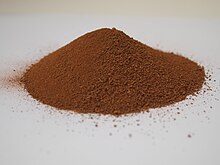
Regolith is a blanket of unconsolidated, loose, heterogeneous superficial deposits covering solid rock. It includes dust, broken rocks, and other related materials and is present on Earth, the Moon, Mars, some asteroids, and other terrestrial planets and moons.

Phoenix was an uncrewed space probe that landed on the surface of Mars on May 25, 2008, and operated until November 2, 2008. Phoenix was operational on Mars for 157 sols. Its instruments were used to assess the local habitability and to research the history of water on Mars. The mission was part of the Mars Scout Program; its total cost was $420 million, including the cost of launch.
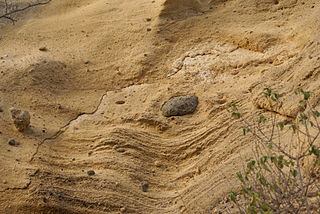
Palagonite is an alteration product from the interaction of water with volcanic glass of chemical composition similar to basalt. Palagonite can also result from the interaction between water and basalt melt. The water flashes to steam on contact with the hot lava and the small fragments of lava react with the steam to form the light-colored palagonite tuff cones common in areas of basaltic eruptions in contact with water. An example is found in the pyroclastic cones of the Galapagos Islands. Charles Darwin recognized the origin of these cones during his visit to the islands. Palagonite can also be formed by a slower weathering of lava into palagonite, resulting in a thin, yellow-orange rind on the surface of the rock. The process of conversion of lava to palagonite is called palagonitization.

In space exploration, in situ resource utilization (ISRU) is the practice of collection, processing, storing and use of materials found or manufactured on other astronomical objects that replace materials that would otherwise be brought from Earth.

Lunar soil is the fine fraction of lunar regolith found on the surface of the Moon and contributes to the Moon's tenuous atmosphere. Lunar soil differs in its origin and properties significantly from terrestrial soil.

David Stewart McKay was chief scientist for astrobiology at the Johnson Space Center. During the Apollo program, McKay provided geology training to the first men to walk on the Moon in the late 1960s. McKay was the first author of a scientific paper postulating past life on Mars on the basis of evidence in Martian meteorite ALH 84001, which had been found in Antarctica. This paper has become one of the most heavily cited papers in planetary science. The NASA Astrobiology Institute was founded partially as a result of community interest in this paper and related topics. He was a native of Titusville, Pennsylvania.
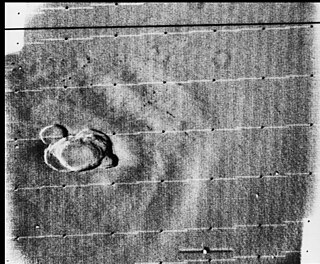
Volcanic activity, or volcanism, has played a significant role in the geologic evolution of Mars. Scientists have known since the Mariner 9 mission in 1972 that volcanic features cover large portions of the Martian surface. These features include extensive lava flows, vast lava plains, and the largest known volcanoes in the Solar System. Martian volcanic features range in age from Noachian to late Amazonian, indicating that the planet has been volcanically active throughout its history, and some speculate it probably still is so today. Both Mars and Earth are large, differentiated planets built from similar chondritic materials. Many of the same magmatic processes that occur on Earth also occurred on Mars, and both planets are similar enough compositionally that the same names can be applied to their igneous rocks.

Martian soil is the fine regolith found on the surface of Mars. Its properties can differ significantly from those of terrestrial soil, including its toxicity due to the presence of perchlorates. The term Martian soil typically refers to the finer fraction of regolith. So far, no samples have been returned to Earth, the goal of a Mars sample-return mission, but the soil has been studied remotely with the use of Mars rovers and Mars orbiters.
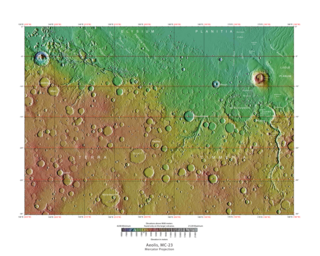
The Aeolis quadrangle is one of a series of 30 quadrangle maps of Mars used by the United States Geological Survey (USGS) Astrogeology Research Program. The Aeolis quadrangle is also referred to as MC-23 . The Aeolis quadrangle covers 180° to 225° W and 0° to 30° south on Mars, and contains parts of the regions Elysium Planitia and Terra Cimmeria. A small part of the Medusae Fossae Formation lies in this quadrangle.
Lunarcrete, also known as "mooncrete", an idea first proposed by Larry A. Beyer of the University of Pittsburgh in 1985, is a hypothetical construction aggregate, similar to concrete, formed from lunar regolith, that would reduce the construction costs of building on the Moon. AstroCrete is a more general concept also applicable for Mars.

A lunar regolith simulant is a terrestrial material synthesized in order to approximate the chemical, mechanical, or engineering properties of, and the mineralogy and particle size distributions of, lunar regolith. Lunar regolith simulants are used by researchers who wish to research the materials handling, excavation, transportation, and uses of lunar regolith. Samples of actual lunar regolith are too scarce, and too small, for such research, and have been contaminated by exposure to Earth's atmosphere.

The composition of Mars covers the branch of the geology of Mars that describes the make-up of the planet Mars.

Sample Analysis at Mars (SAM) is a suite of instruments on the Mars Science Laboratory Curiosity rover. The SAM instrument suite will analyze organics and gases from both atmospheric and solid samples. It was developed by the NASA Goddard Space Flight Center, the Laboratoire des Atmosphères Milieux Observations Spatiales (LATMOS) associated to the Laboratoire Inter-Universitaire des Systèmes Atmosphériques (LISA), and Honeybee Robotics, along with many additional external partners.

CheMin, short for Chemistry and Mineralogy, is an instrument located in the interior of the Curiosity rover that is exploring the surface of Gale crater on Mars. David Blake, from NASA Ames Research Center, is the Principal Investigator.
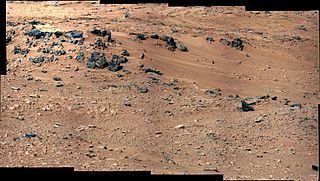
Rocknest is a sand patch on the surface of Aeolis Palus, between Peace Vallis and Aeolis Mons, in Gale crater on the planet Mars. The patch was encountered by the Curiosity rover on the way from Bradbury Landing to Glenelg Intrigue on September 28, 2012. The approximate site coordinates are: 4.59°S 137.44°E.

A Mars habitat is a hypothetical place where humans could live on Mars. Mars habitats would have to contend with surface conditions that include almost no oxygen in the air, extreme cold, low pressure, and high radiation. Alternatively, the habitat might be placed underground, which helps solve some problems but creates new difficulties.

Martian lava tubes are volcanic caverns on Mars that are believed to form as a result of fast-moving, basaltic lava flows associated with shield volcanism. Lava tubes usually form when the external surface of the lava channels cools more quickly and forms a hardened crust over subsurface lava flows. The flow eventually ceases and drains out of the tube, leaving a conduit-shaped void space which is usually several meters below the surface. Lava tubes are typically associated with extremely fluid pahoehoe lava. Gravity on mars is about 38% that of Earth's, allowing Martian lava tubes to be much larger in comparison.

The Swamp Works is a lean-development, rapid innovation environment at NASA's Kennedy Space Center. It was founded in 2012, when four laboratories in the Surface Systems Office were merged into an enlarged facility with a modified philosophy for rapid technology development. Those laboratories are the Granular Mechanics and Regolith Operations Lab, the Electrostatics and Surface Physics Lab, the Applied Chemistry Lab, and the Life Support and Habitation Systems (LSHS) team. The first two of these are located inside the main Swamp Works building, while the other two use the facility although their primary work is located elsewhere. The team developed the Swamp Works operating philosophy from Kelly Johnson's Skunk Works, including the "14 Rules of Management", from the NASA development shops of Wernher von Braun, and from the innovation culture of Silicon Valley. The team prototypes space technologies rapidly to learn early in the process how to write better requirements, enabling them to build better products, rapidly, and at reduced cost. It was named the Swamp Works for similarity with the Skunk Works and the Phantom Works, but branded by the widespread marshes (swamps) on the Cape Canaveral and Merritt Island property of the Kennedy Space Center. The Swamp Works was co-founded by NASA engineers and scientists Jack Fox, Rob Mueller, and Philip Metzger. The logo, a robotic alligator, was designed by Rosie Mueller, a professional designer and the spouse of Rob Mueller.
Astropedology is the study of very ancient paleosols and meteorites relevant to the origin of life and different planetary soil systems. It is a branch of soil science (pedology) concerned with soils of the distant geologic past and of other planetary bodies to understand our place in the universe. A geologic definition of soil is “a material at the surface of a planetary body modified in place by physical, chemical or biological processes”. Soils are sometimes defined by biological activity but can also be defined as planetary surfaces altered in place by biologic, chemical, or physical processes. By this definition, the question for Martian soils and paleosols becomes, were they alive? Astropedology symposia are a new focus for scientific meetings on soil science. Advancements in understanding the chemical and physical mechanisms of pedogenesis on other planetary bodies in part led the Soil Science Society of America (SSSA) in 2017 to update the definition of soil to: "The layer(s) of generally loose mineral and/or organic material that are affected by physical, chemical, and/or biological processes at or near the planetary surface and usually hold liquids, gases, and biota and support plants". Despite our meager understanding of extraterrestrial soils, their diversity may raise the question of how we might classify them, or formally compare them with our Earth-based soils. One option is to simply use our present soil classification schemes, in which case many extraterrestrial soils would be Entisols in the United States Soil Taxonomy (ST) or Regosols in the World Reference Base for Soil Resources (WRB). However, applying an Earth-based system to such dissimilar settings is debatable. Another option is to distinguish the (largely) biotic Earth from the abiotic Solar System, and include all non-Earth soils in a new Order or Reference Group, which might be tentatively called Astrosols.
Joanna V. Clark is a geoscientist working for the NASA Johnson Space Center, where she is a collaborator on the Sample Analysis at Mars (SAM) and Mars Science Lab (MSL) science teams. Her research includes conducting laboratory experiments to understand better ground and mineral samples acquired by the curiosity rover on Mars.
